Art World
The Biennial Stars: Meet the 24 (Perhaps Unexpected) Artists Who Have Defined Our Current Era of International Art Shows
Each of these artists has appeared in eight or more international art surveys since 2017.
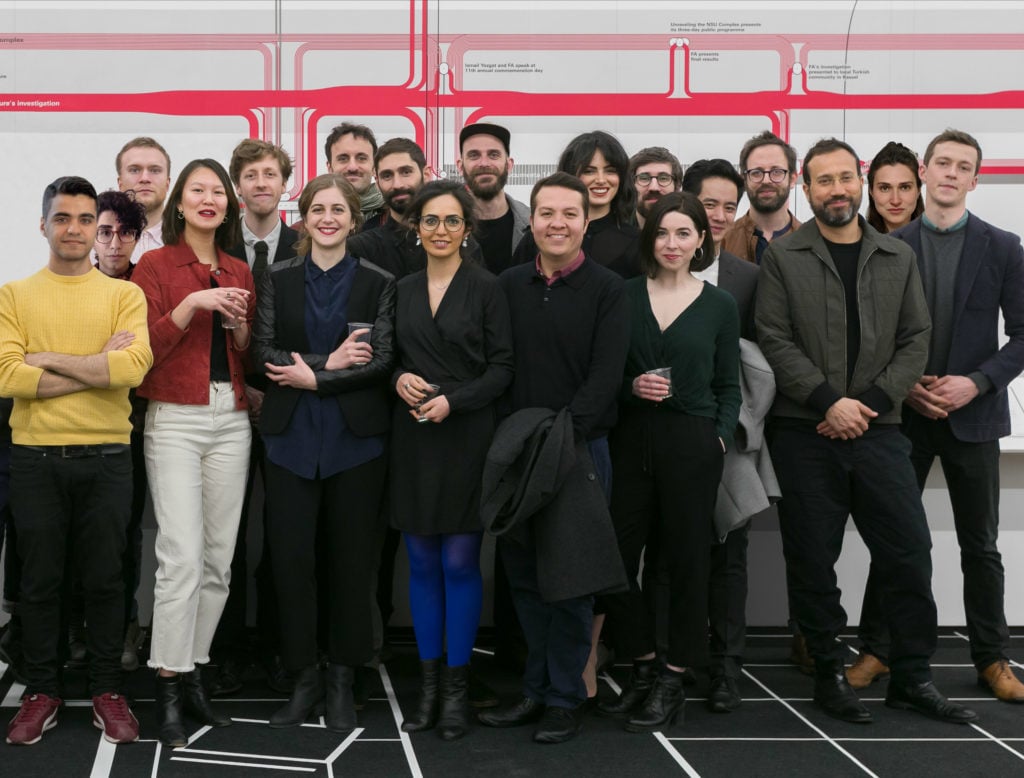
Each of these artists has appeared in eight or more international art surveys since 2017.

Artnet News

This is part of the Biennial Artist Project, a series on the stars of the biennial circuit. You can also read our critic’s take on the list and a report on the economics of being a biennial star. The full list of biennial artists (and which galleries represent them) is available to Artnet News Pro members.
If you could somehow see every biennial or triennial in the last five years, what patterns would emerge? Which stars would shine brightest?
For this project, we analyzed the artist lists for 211 recurring international art events that have happened or been announced in the five years since the opening of Documenta 14 in April 2017. This is a somewhat arbitrary time period (the 2017 Venice Biennale is not included, since it opened in February 2017, while the 2017 Skulptur Projekte Münster is, since it opened in June of that same year). However, with Documenta 15 about to open, it gives a convenient window to look at the figures who have defined the zeitgeist of this particular half decade in art.
The resulting list looks at figures in big events like the Venice Biennale and the São Paulo Biennial. But it also takes into account many new biennials that sprung up in this period (and that may or may not carry on), as well as hard-to-classify events like Bienalsur, which is technically based in Argentina but seeks to create a simultaneous art conversation about the Global South in far-flung venues, from Houston to Riyadh.
Chronologically, the final artist list included in our tally comes from the upcoming 2023 Sharjah Biennale, which was announced years ago; delayed by the pandemic, it is the final show organized by the late Okwui Enwezor. For the sake of providing some kind of limit to the selection, we didn’t include architecture, design, or photo biennials, focusing on shows dedicated to art (admittedly a somewhat arbitrary disciplinary distinction).
While we are bound to have left out some events, the overall pattern is striking enough that it is not likely to change considerably. Overall, 1,599 artists emerged who had appeared in more than one of these big survey shows in this time period (the full list is available to Artnet News Pro subscribers); 591 appeared in three or more; 260 in four or more; and so on. The list, in other words, follows the classic superstar distribution, with attention becoming more concentrated the higher you go, and narrowing to focus on an elite with many times the exposure of the rest.
Below are this era’s 23 biggest biennial stars, comprising all the artists we found who appeared in eight or more biennials in the past five years.
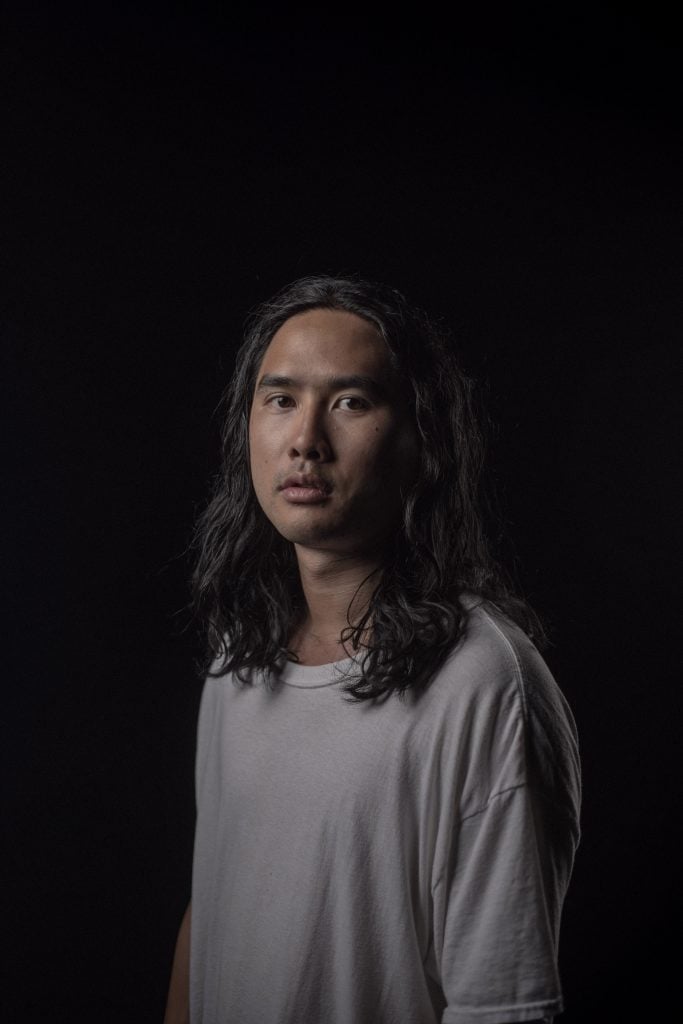
Korakrit Arunanondchai. Photo: Benjamin Bechet.
Born: 1986
Based in: Bangkok and Brooklyn
Appeared in: Athens Biennale 2018; Baltic Triennial 2018; Biennale de l’Image en Mouvement 2018; October Salon/Belgrade Biennale 2018; Asian Art Biennial (Taiwan) 2019; Venice Biennale 2019; Whitney Biennial 2019; Istanbul Biennial 2019; Performa 2019; Singapore Biennale 2019; Yokohama Triennale 2020; Biennale Gherdëina 2020; Gwangju Biennale 2021; Kathmandu Triennale 2022
Notable Works: No History in a Room Filled With Funny Names 5 (2018)
Arunanondchai is a globe-trotting contemporary-art polymath, working between painting, installation, film, and performance. Since graduating from Columbia’s MFA program in 2012, Arunanondchai has become best known for immersive video installations like No History in a Room Filled With Funny Names 5, shown at the Biennale de l’Image en Mouvement in 2018 and then in Venice in 2019, weaving together personal narrative, current events, Thai folklore, queer club aesthetics, and more.
“In Western white spaces, the work often sits in a neutral ground where ‘a life lived’ doesn’t really enter—it’s like life contaminates the space of art,” he told the White Review last year, explaining his method. “And when life is allowed to enter, it suddenly dominates…how the work can be read. I wanted to find a type of storytelling where all my interests could come together, without these limitations.”
Like many artists on this list, Arunanondchai is also a quintessential collaborator, creating works alongside a recurring cast of colleagues including performer boychild and director and installation designer Alex Gvojic. Ubiquitous on the global biennial scene in the past five years, Arunanondchai has also organized his very own biennial-type event: the Ghost Festival, which brought a cohort of other biennial stars to Thailand in 2018, including Ian Cheng and Samson Young.
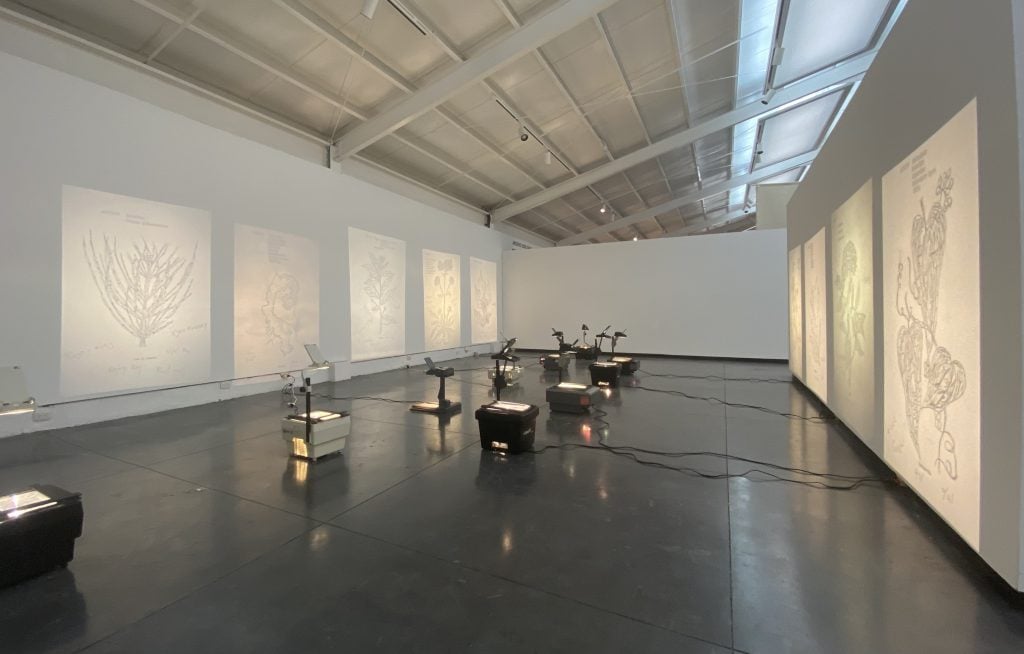
Uriel Orlow, Cómo se llamaban las plantas antes de que tuvieran nombre (Guatemala) (2020-2021). Photo by Hugo Quinto, courtesy of Alexia Tala.
Born: 1973
Based in: London and Lisbon
Appeared in: Manifesta 2018; Moscow Biennale 2018; Yinchuan Biennale 2018; Taipei Biennial 2020; Coventry Biennial 2019; Lubumbashi Biennale 2019; Bienal de Arte Paiz 2021; Momentum Biennial 2021; Thailand Biennale 2021; Vienna Biennale for Change 2021; Berlin Biennale 2022; British Art Show 2022; Kathmandu Triennale 2022; Mardin Biennial 2022
Notable Works: Wishing Trees (2018), Learning from Artemisia (2019)
The Switzerland-born Orlow is known for honing in on specific locations and micro-histories, often using botanical knowledge to explore the notion of plants as political actors, and elsewhere the legacies of colonialism, spatial manifestations of memory, and blind spots of representation.
Spanning film, drawing, photography, and sound, his work is particularly well-suited to the biennial format because it speaks to both the local context and universal themes. It stresses long-term collaboration and often involves relationships that persist “beyond the time-frame of the biennial,” gallerist Arthur Gruson told Artnet News. “Orlow’s anchoring of his projects in a particular place whilst addressing translocal issues and his commitment to finding meaningful image regimes and modes of representation result in artistic contributions that have a socio-political grounding and are valued by local as well as international audiences.”

Lawrence Abu Hamdan poses for a portrait during the ceremonies for the Turner Prize 2019. (Photo by Stuart C. Wilson/Stuart Wilson/Getty Images for Turner Contemporary)
Born: 1985
Based in: Dubai
Appeared in: Asian Art Biennial (Taiwan) 2017; Biennale de l’Image en Mouvement 2018; Art Encounters Biennial (Romania) 2019; Bienalsur 2019; Coventry Biennial 2019; Ljubljana Biennial of Graphic Arts 2019; Sharjah Biennial 2019; Venice Biennale 2019; Sydney Biennale 2020; Havana Biennial 2021; São Paulo Biennial 2021; Berlin Biennale 2022; Toronto Biennial 2022
Notable Works: Walled Unwalled (2018); After SFX (2018)
Lawrence Abu Hamdan famously styles himself a private ear (as opposed to a “private eye”). His artwork and research often involve careful investigations of sounds and voices as witnesses of violence and injustice. He works in video, audio documentaries, installations, and workshops to examine the thresholds of sound and voice, often leaning on sound as a vehicle for truth in the absence of visual information.
Recent subjects include the trial of Oscar Pistorius and the recollections of survivors of Saydnaya prison who were kept in darkness at all times. In 2019, Abu Hamdan jointly won the Turner Prize for his exhibition “Earwitness Theatre” and for his performance After SFX, which was also seen at the 2021 São Paulo Biennial.
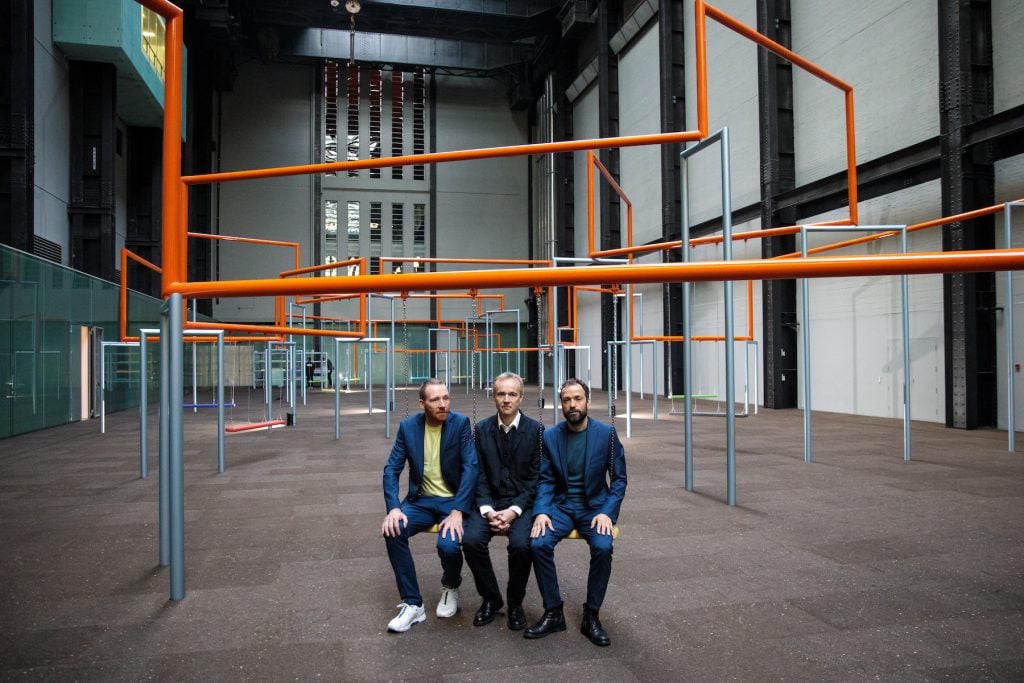
Members of the Danish collective Superflex [left to right] Jakob Fenger, Rasmus Nielsen and Bjornstjerne Christiansen pose with their Turbine Hall installation at the Tate Modern. (Photo by Jack Taylor/Getty Images)
Based in: Copenhagen
Appeared in: ARoS Triennial 2017; Gwangju Biennale 2018; Qalandiya International 2018; Desert X 2019; Thessaloniki Biennale 2019; Vienna Biennale for Change 2019; Desert X AlUla 2020; Thailand Biennale 2021; Vienna Biennale for Change 2021; North Atlantic Triennial 2022; Riga Biennial 2022
Notable Works: Deep Sea Minding (2018–21); The Mammoth Rehearsal Sessions (2021)
The Danish art group Superflex has spent more than a quarter century creating their hard-to-categorize, sometimes humorous, always socially engaged art. The collective—whose founding members are Bjornstjerne Christiansen, Jakob Fenger and Rasmus Nielsen—works collaboratively, both among themselves (no one member ever gets credit for an idea) and with bureaucratic institutions and larger research institutions of various kinds. “We like to engage with systems by going inside to challenge them,” Christiansen told the New York Times. “When you’re inside, you can stir things up much more.”
Multiple works created between 2017 and 2022 spun off from their larger, three-year initiative Deep Sea Minding, an ambitious melding of science, art, and environmentalism that involved a series of voyages aimed at researching the possibilities of new types of marine habitats that respond to a warming world. Their climate-change drive-in movie installation, Dive-In, at the 2019 Desert X Biennial was made of the coral-pink material they have created for this purpose, in anticipation of a possible future desert flooded by rising seas. For The Mammoth Rehearsal Sessions at the Thailand Biennale in 2021, they set up a group hypnosis session where art lovers were prompted to imagine themselves as wooly mammoths being driven to extinction.
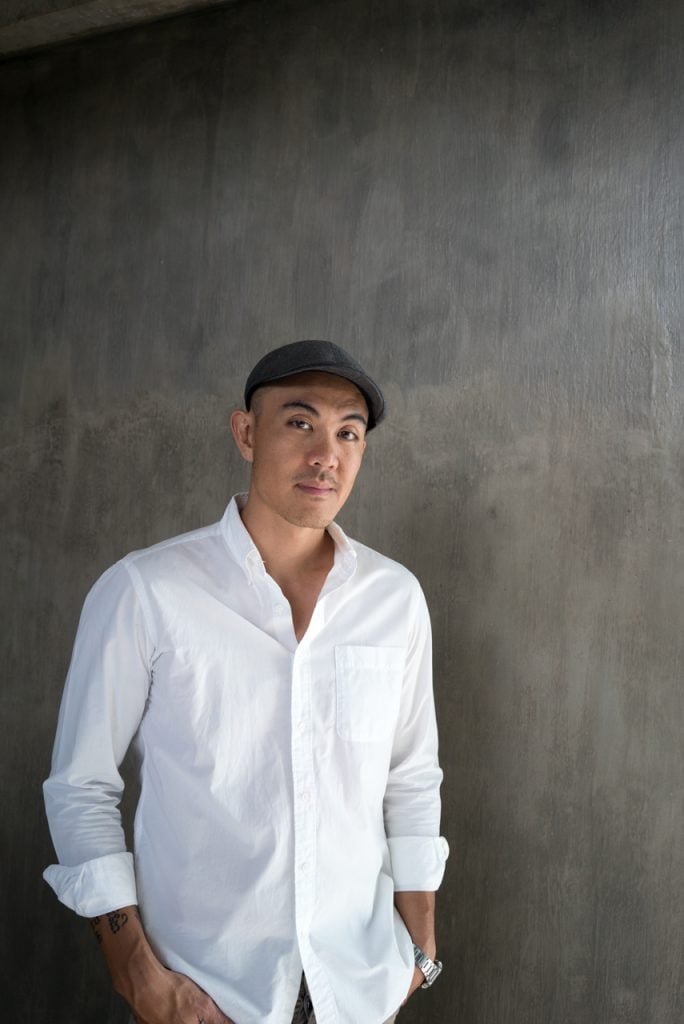
Tuan Andrew Nguyen. Image courtesy the artist and James Cohan, New York.
Formed: 1976
Based in: Ho Chi Minh City
Appeared in: ARos Triennial 2017; Yokohama Triennale 2017; Sharjah Biennial 2019; Dhaka Art Summit 2020; Manifesta 2020; Shanghai Biennial 2020; Asian Art Biennial (Taiwan) 2021; Aichi Triennale 2022; Berlin Biennale 2022; Dakar Biennale 2022; Manifesta 2022
Notable Works: The Two Tuans (1998); The Island (2017); The Specter of Ancestors Becoming (2019)
Among other things, Nguyen is a member of the Propeller Group, a Vietnamese collective known for its satirical Television Commercial for Communism (2011–2012). As a solo artist, he has found massive success with a style of reflective, research-based video art that sometimes edges into science fiction, but that equally reflects on his research into real histories and the legacy of colonialism.
The Specter of Ancestors Becoming (2019), shown among other places at the Dakar Biennale and the Berlin Biennale, looks at the children of Senegalese men and Vietnamese women who met when Senegalese soldiers were deployed by the occupying French. His 2017 work The Island is set on the Malaysian island of Pulau Bidong—historically freighted as the site of a refugee camp where Nguyen himself once lived with his family, but now left to ruins—using it as the setting of a narrative set after nuclear armageddon.
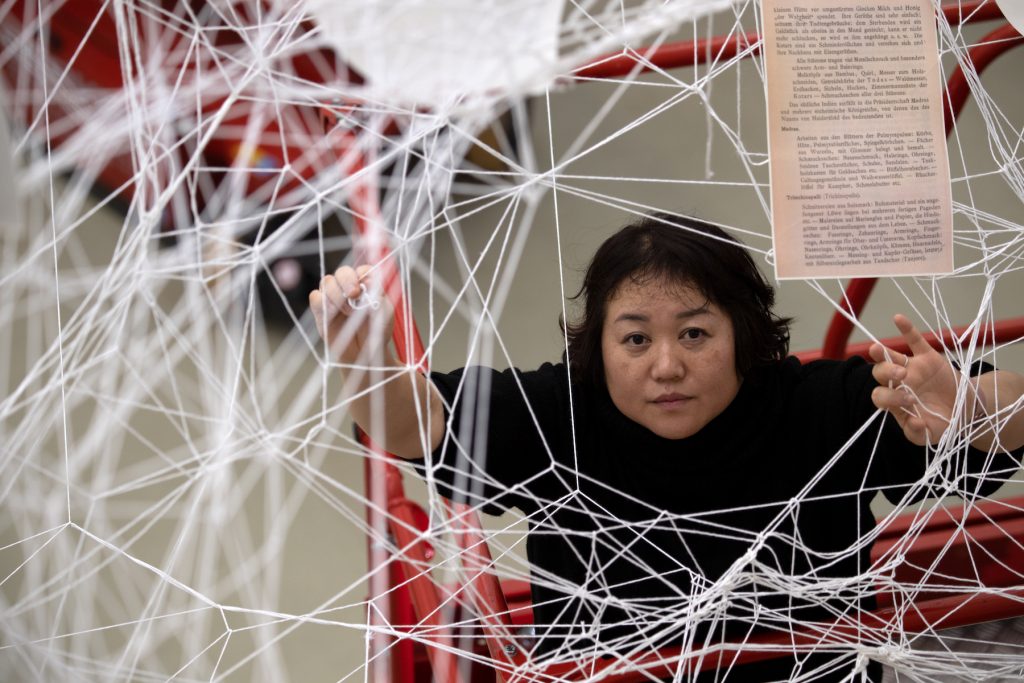
Chiharu Shiota, artist, working on a huge installation in the foyer of the Gropius Bau, June 2019. (Photo by Ralf Hirschberger/picture alliance via Getty Images)
Born: 1972
Based in: Berlin
Appeared in: Jakarta Biennale 2017; Oku-Noto Triennale 2017; OpenArt (Sweden) 2017; Socle du Monde Biennale 2017; October Salon/Belgrade Biennale 2018; Shenzhen Biennale 2018; Honolulu Biennial 2019; Manifesta 2022; Setouchi Triennale 2019; Bangkok Biennale 2022; Oku-Noto Triennale 2020
Notable Works: Becoming Painting (1994); The Key in the Hand (2015)
The Japanese-born artist is best known for creating immersive installations with interwoven skeins of thread. Her massive nets hold small personal objects like keys and spring from desks, boats, or bed frames. Born in 1972 in Osaka, Shiota studied painting at Kyoto Seika University before moving to Berlin to train with Marina Abramovic.
Her artistic breakthrough came in 1994, when she staged Becoming Painting, a performance in which she poured toxic red enamel paint over her body, burning her skin in the process. The work marked her break with painting and the beginning of her quest to place both the artist and the viewer inside her own creations. Perhaps her most famous installation, The Key in the Hand, was her contribution to the Japanese Pavilion at the Venice Biennale in 2015. She transformed the exhibition space into a web of red yarn; at the end of each thread was a key.
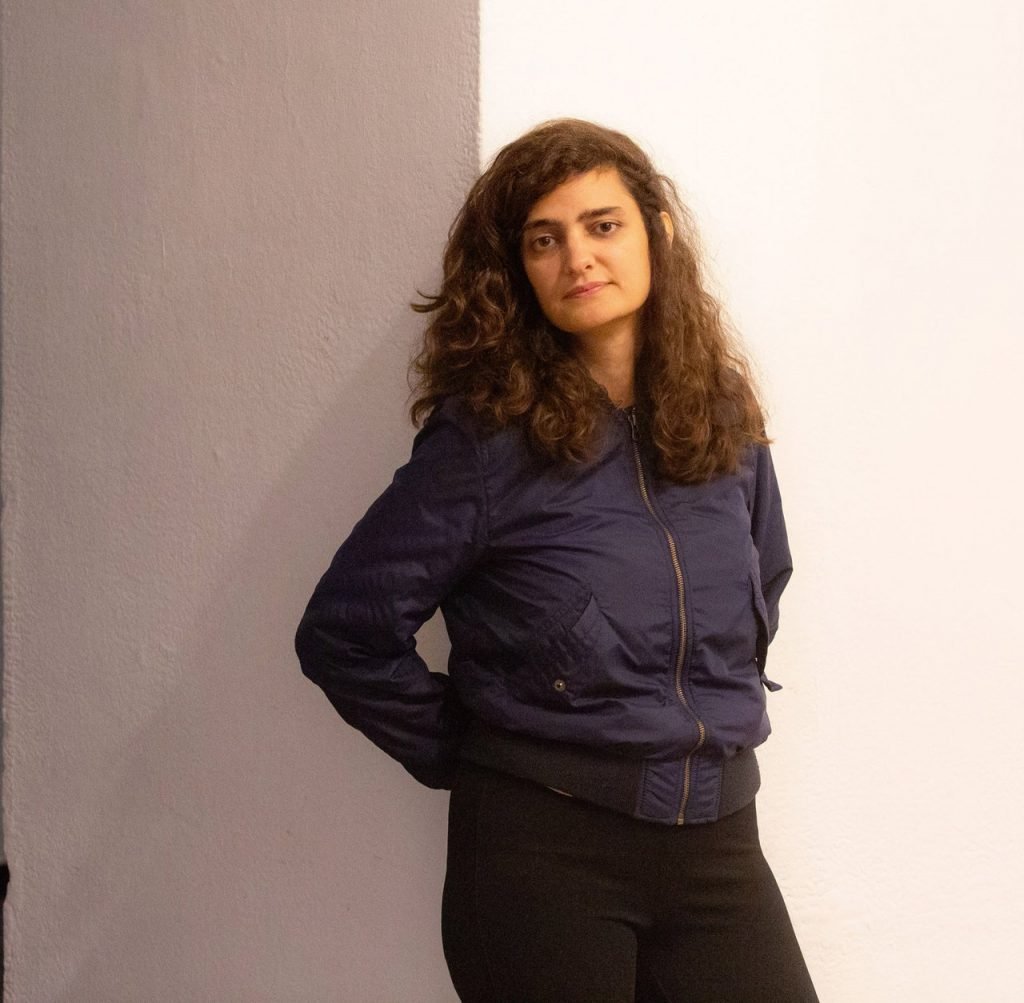
Marwa Arsanios. Photo: Nada Zgank. Courtesy of the Onassis Foundation.
Born: 1978
Based: Berlin and Beirut
Appeared in: Gwangju Biennale 2018; Luleå Biennial 2018; Qalandiya International 2018; Biennale Warszawa 2019; Sharjah Biennial 2019; Berlin Biennale 2020; Lahore Biennial 2020; Autostrada Biennale 2021; Documenta 2022; Mardin Biennial 2022
Notable Works: Who is Afraid of Ideology (2017–21)
Architectural models, magazine back issues, topographic maps, first-person interviews—these are the materials that fuel the work of Marwa Arsanios. Born in Washington, D.C. and educated at the Lebanese American University in Beirut and the University of the Arts, London, Arsanios creates films, installations, and even textiles that emerge from a rigorous research process.
Much of her work examines dynamics at the intersection of feminist politics, resistance movements, and struggles over land. Her ambitious film series Who is Afraid of Ideology (2017–21) knits together the experiences of Indigenous farmers and organizers in Colombia, Mexico, Syria, Iraq, and northern Lebanon, as well as activists from the Kurdish autonomous women’s movement.

Portrait of Naeem Mohaiemen. Photo by Abeer Hoque, courtesy Turner Prize.
Born: 1969
Based in: New York
Appeared in: Bucharest Biennale 2018; Front Triennial 2018; Industrial Art Biennial (Croatia) 2018; Lahore Biennial 2018; Liverpool Biennial 2018; Art Encounters Biennial (Romania) 2019; Yokohama Triennale 2020; Kyiv Biennial 2021; OFF Biennale (Hungary) 2021; Front Triennial 2022
Notable Works: United Red Army (2011); Tripoli Cancelled (2017); Two Meetings and a Funeral (2017)
Now teaching at Columbia University, Mohaimen participated in the Visible Collective in the 2000s, an important group that agitated around the persecution of Arabs and Muslims at the height of the U.S. War on Terror. In the 2010s, he became celebrated for ambitious, expansive film installations like Two Meetings and a Funeral, premiered at Documenta in 2017, which concentrates on the Non-Aligned Movement of countries that tried to escape the bipolar order of the Cold War as the seed of a potential alternate political history, featuring Marxist historian Vijay Prashad.
“I say what I do is a critique imbricated with love for this movement,” he told Bidoun when he was nominated for the Turner Prize in 2018. “But it is not naive. The story is tragic, but it’s more Shakespearean than Greek. Failure was not inevitable.”
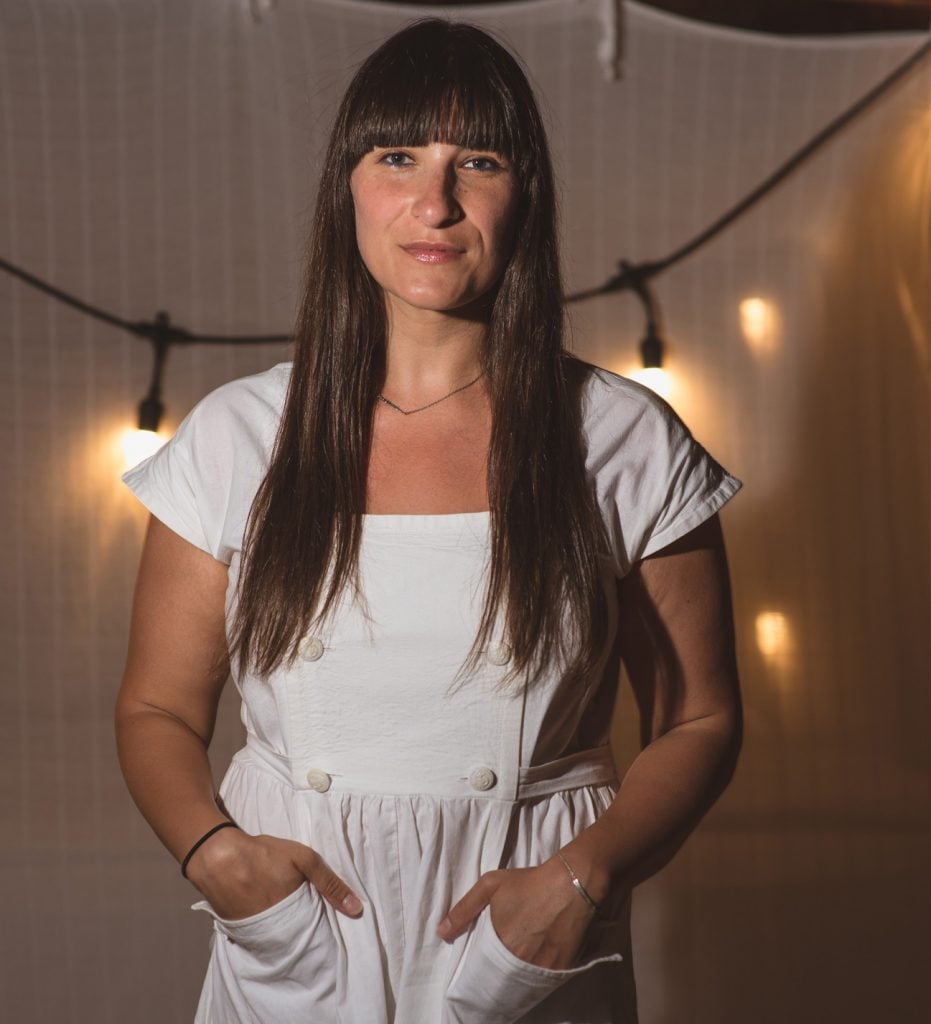
Taus Makhacheva. Courtesy of Sharjah Art Foundation.
Born: 1983
Based in: Moscow
Appeared in: Ural Industrial Biennial 2017; Liverpool Biennial 2018; Manifesta 2018; Riga Biennial 2018; Yinchuan Biennale 2018; Art Encounters Biennial (Romania) 2019; Lyon Biennale 2019; Bangkok Biennale 2020; Lahore Biennial 2020; Yokohama Triennale 2020
Notable Works: Tightrope (2015); Quantitative Infinity of the Objective (2019)
The artist made a splash in the international art world with Tightrope (2015), a video that captured a tightrope walker carrying 61 copies of works from the collection of the Dagestan Museum of Fine Art across a Caucasus ravine. Like much of Makhacheva’s work, the video—which was included in the 2017 Venice Biennale—explores the factors that shape national identity and what happens when two cultures collide. (The artist grew up in Moscow but her roots are in Dagestan, which came under Russian control in the early 19th century.)
Since then, Makhacheva has moved away from work focused on specific geographies to explore physical and emotional transformation. At the 2018 Liverpool Biennale, she set up a fully functioning spa with custom beauty products and ASMR video backdrops. At the Yokohama Triennale, she presented Quantitative Infinity of the Objective (also shortlisted for the Future Generation Art Prize), a room full of offbeat gym equipment that was activated by live gymnasts.
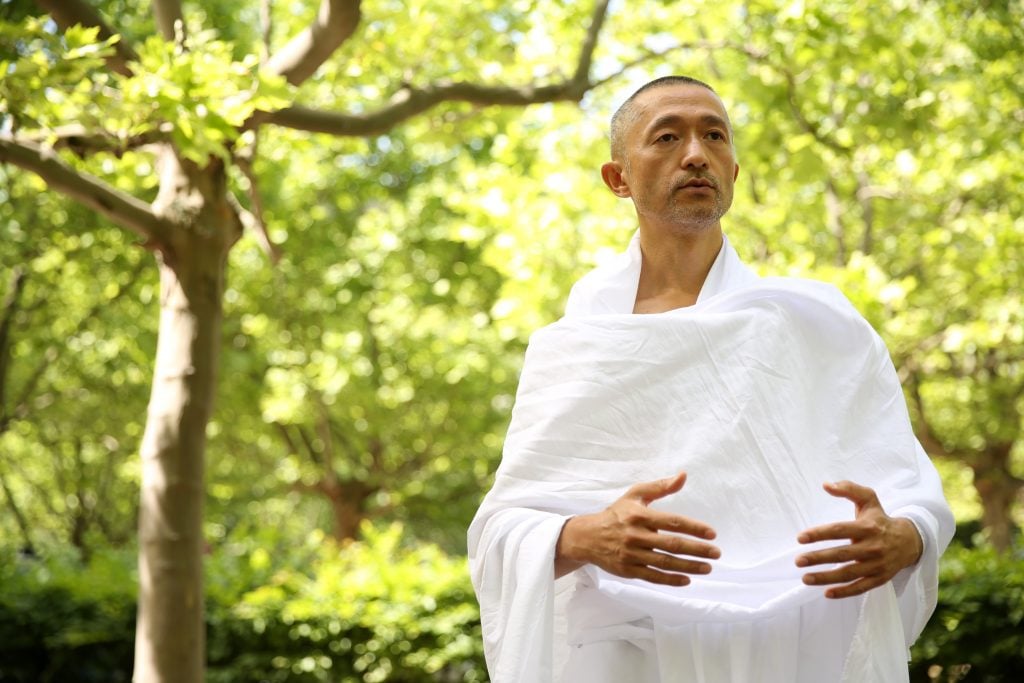
Artist Zheng Bo leads visitors in an “Ecosensibility Exercise” during his exhibition entitled “Wanwu Council 萬物社” at Martin Gropius Bau in Berlin, Germany. (Photo by Adam Berry/Getty Images)
Born: 1974
Based in: Lantau Island, Hong Kong
Appeared in: Manifesta 2018; Taipei Biennial 2018; Thailand Biennale 2018; Yinchuan Biennale 2018; Yokohama Triennale 2020; Guangzhou Image Triennial 2021; Liverpool Biennial 2021; Hawai’i Triennial 2022; Venice Biennale 2022; Sydney Biennale 2022
Notable works: Pteridophilia (2016–); Le Sacre du printemps (Tandvärkstallen) (2021)
Born in Beijing, Zheng now resides on Hong Kong’s largest outlying island of Lantau, one of the financial hub’s last vestiges of nature. This choice of habitat is almost a mirror of his socially and ecologically engaged art practice.
Zheng’s ongoing research, performance, and video art investigates human-plant coexistence, “inviting us to rethink our positions and relationships with nature, ecology, and social aspects in our world,” independent curator Angelika Li told Artnet News. The notion of interconnectedness among all living beings explored in Zheng’s work resonates especially strongly in the wake of the pandemic, Li added: “His projects create space for us to breathe and meditate, bringing us the awareness of the meditative and spiritual qualities from nature, the qualities that we once were not aware of.”
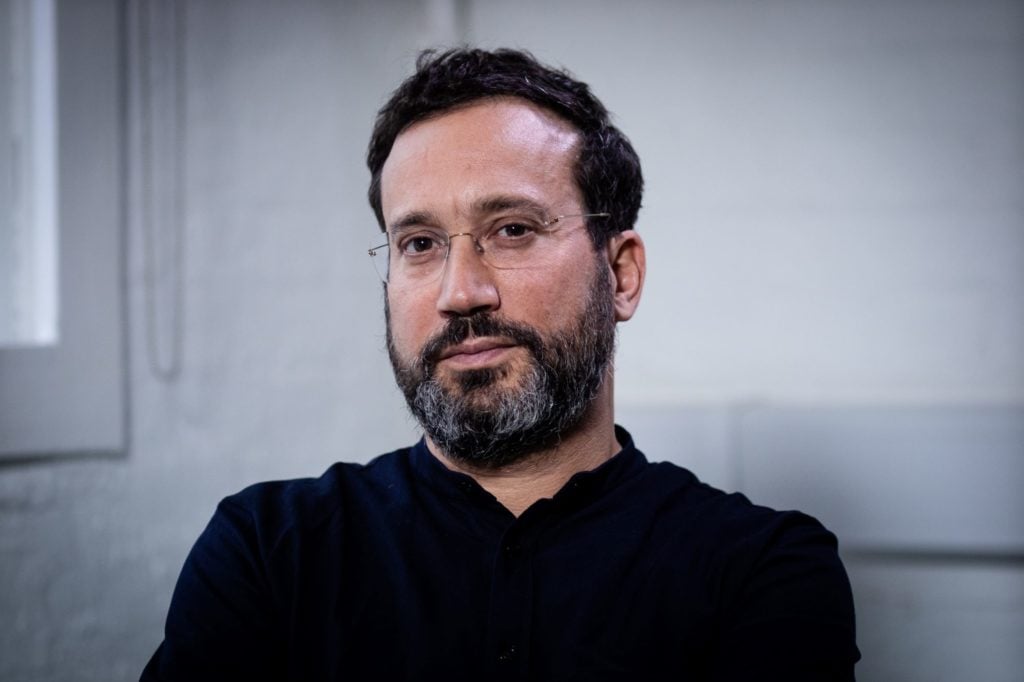
Eyal Weizman, the director of Forensic Architecture. Courtesy of Forensic Architecture.
Established: 2010
Based in: London
Appeared in: Ural Industrial Biennial 2017; Manifesta 2018; Moscow Biennale 2018; Shanghai Biennale 2018; Art Encounters Biennial (Romania) 2019; Whitney Biennial 2019; Bienal de Arte Paiz 2021; Berlin Biennale 2022; Biennale Warszawa 2022
Notable Works: The Long Duration of a Split Second (2018–19); Triple Chaser (2019)
Formed in 2010 under the auspices of the art school Goldsmiths, Forensic Architecture has grown into a hybrid research center, watchdog organization, and art collective with powerful allies like Human Rights Watch and Amnesty International. The group of data analysts, architects, sound engineers, and even smell specialists use everything from cell-phone video to detailed reenactments in order to uncover lies, human rights violations, and crimes committed by some of the world’s most powerful.
One of the group’s most impactful projects, The Long Duration of a Split Second, began as a means to clarify what exactly happened on the night hundreds of Israeli policemen raided a Bedouin village to demolish a few houses and two people ended up dead. Compiling footage and sound clips recorded by witnesses, as well as interviews, models, and press clippings, Forensic Architecture was able to prove that police had, indeed, opened fire first. Its video installations, which have been displayed at museums and biennials around the globe, stubbornly refuse to aestheticize these investigations, and instead lay out in clear-eyed, methodical fashion how the collective arrives at its conclusions.
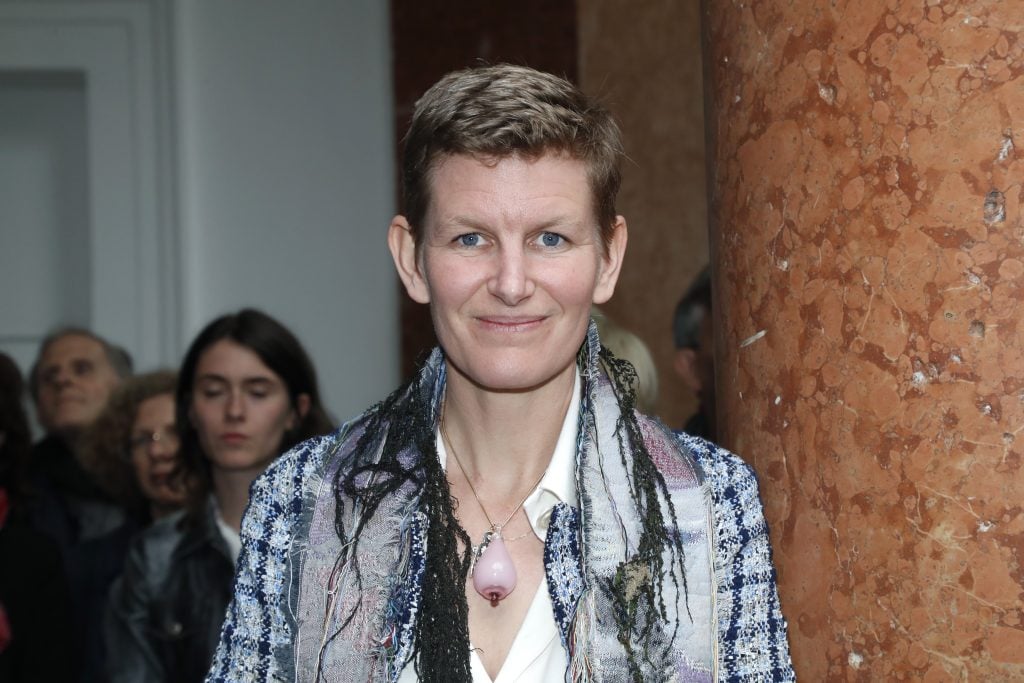
Laure Prouvost, with her Exhibition “Deep see blue surrounding you / Vois ce bleu profond te fondre” attends the 58th International Art Biennale on May 08, 2019 in Venice, Italy. (Photo by Bertrand Rindoff Petroff/Getty Images)
Born: 1978
Based in: Brussels
Appeared in: Industrial Art Biennial (Croatia) 2018; Baltic Triennial 2018; Moscow Biennale 2018; Sydney Biennale 2020; Art Encounters Biennial (Romania) 2021; Bienalsur 2021; Sonsbeek 2021; Busan Biennale 2022
Notable Works: Wantee (2013); DIT LEARN (2017)
Don’t believe everything you read about Laure Prouvost. The Lille-born artist is known for blending fact and fiction in her videos, multimedia installations, tapestries, and other work. The project that won her the Turner Prize, Wantee (2013), tells the fictional story of her grandfather, a famous conceptual artist who disappeared into a tunnel under his house. Deconstruction and disorientation are common themes: For the 2017 Venice Biennale, for which she represented France, Prouvost invited visitors to enter the pavilion from underground and walk through a labyrinth of videos and performances in a space that evoked a drained ocean. Octopuses, breasts, and punny language also make frequent appearances in Prouvost’s surreal, arch work.
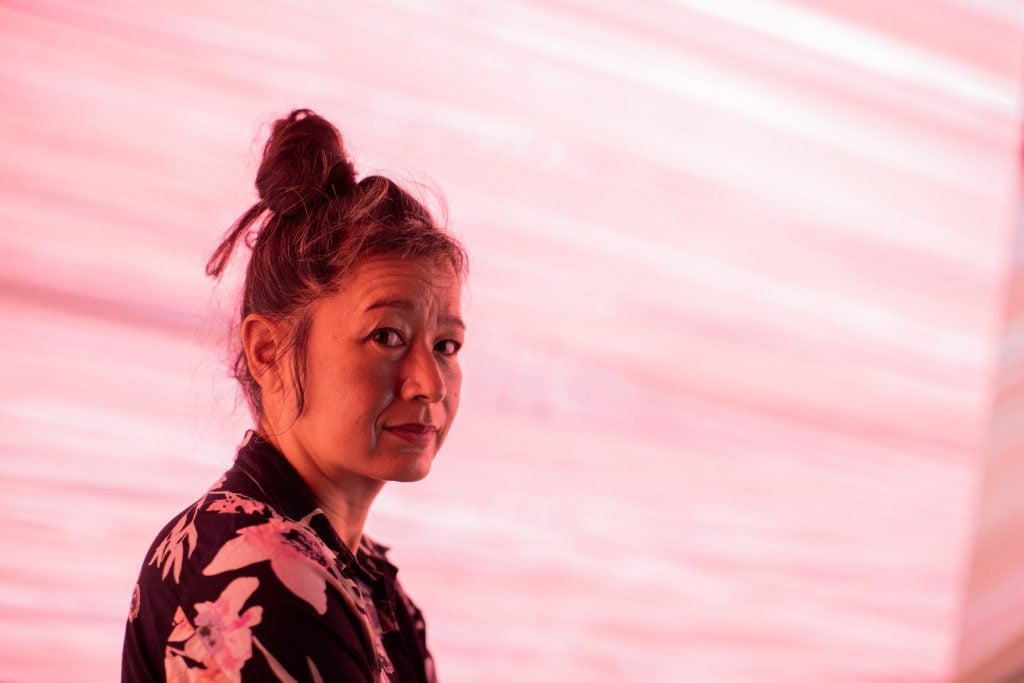
Hito Steyerl, artist, in the art collection K21. (Photo by Rolf Vennenbernd/picture alliance via Getty Images)
Born: 1966
Based in: Berlin
Appeared in: Skulptur Projekte Münster 2017; Bienalsur 2017; Jakarta Biennale 2017; Busan Biennale 2018; Ghost Festival 2018; Kyiv Biennial 2019; OpenArt (Sweden) 2019; Venice Biennale 2019; Art Encounters Biennial (Romania) 2021
Notable Works: Liquidity, Inc. (2014); Factory of the Sun (2015)
The Munich-born artist is known for videos and installations that explore financial systems, surveillance, migration, and militarization through a mix of barbed humor and dogged research. She’s not afraid to bite the hand that feeds her: she declined the German government’s Federal Cross of Merit to protest its failure to support artists during lockdown, and created an augmented reality app for her show at the Serpentine that erased the Sackler family’s name from the facade. (The gallery has since done the same IRL.) One of her contributions to the 2019 Venice Biennale was Leonardo’s Submarine, a video installation targeting the arms manufacturer Finmeccanica, which has supplied weapons used by the Turkish armed forces against civilians in Syria and sold war planes to Saudi Arabia.
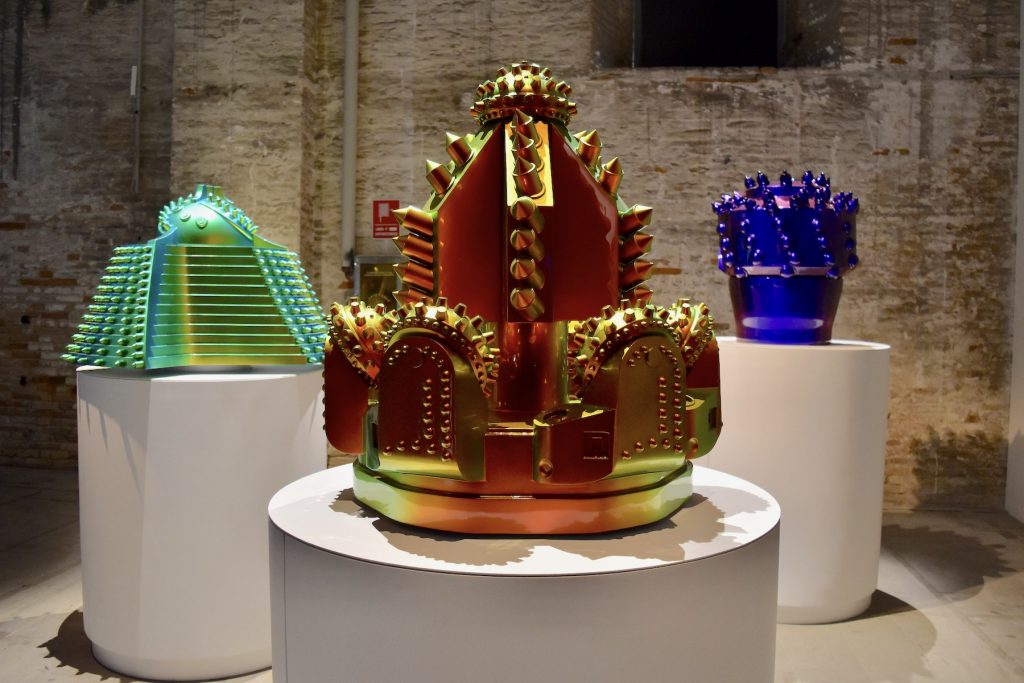
Monira al Qadiri, Orbital (2022). Photo by Ben Davis.
Born: 1983
Based in: Berlin
Appeared in: Asia Pacific Triennial 2018; Athens Biennale 2018; Luleå Biennial 2018; Aichi Triennale 2019; Seoul Mediacity Biennale 2021; Venice Biennale 2022; Sharjah Biennial 2023; Asian Art Biennial (Taiwan) 2021; Guangzhou Image Triennial 2021
Notable Works: Alien Technology (2014–19); OR-BIT (2016)
Al Qadiri was born in Senegal, where her father was a diplomat, grew up in Kuwait, moved to Japan by herself when she was 16 years old, and now lives in Berlin. “As an artist I don’t feel like I belong anywhere,” she said in a recent interview. “I am a mutant.”
Working in a variety of media including film, installation, and sculptural objects that range from neon signs to robotics, she explores such subjects as unconventional gender identities, petrol culture, and the death of international diplomacy. Alien abductions and floating hamburgers have made an appearance here and there. “I see all my work as a self-portrait,” she said. “Even though it’s a sculpture or a video, even though I am not in it.”
For this year’s Venice Biennale, Al Qadiri contributed sculptures resembling oil drills coated in iridescent automotive paint—at once glittery trophies and symbols of environmental devastation.
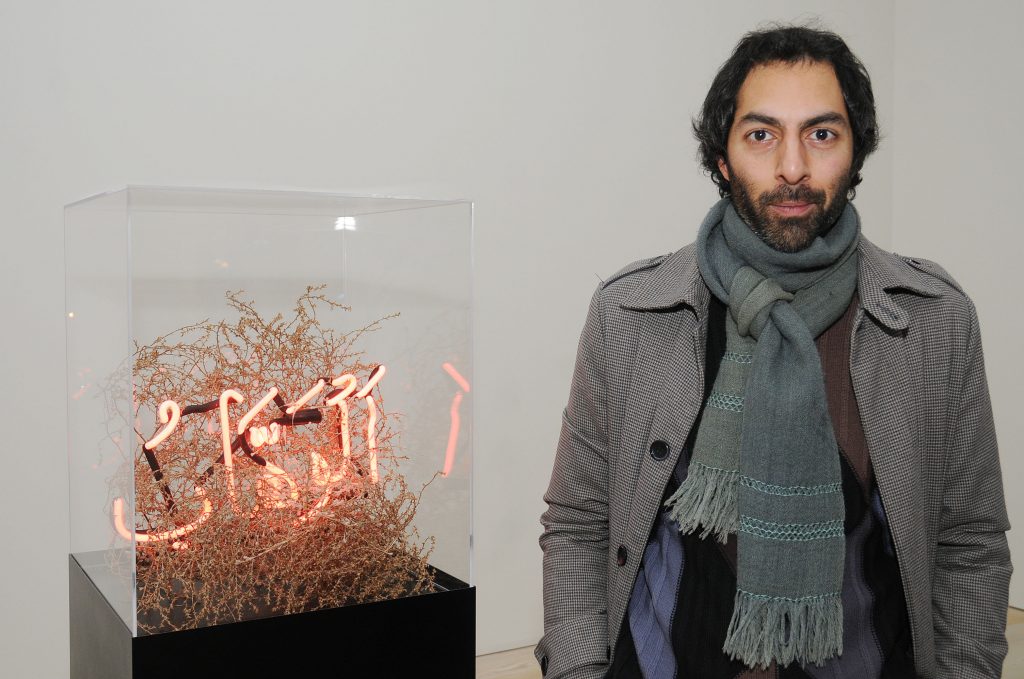
Artist Shezad Dawood poses next to his artwork on display at “The Empire Strikes Back – Indian Art Today” at the Saatchi Gallery on January 28, 2010 in London, England. (Photo by Stuart Wilson/Getty Images)
Born: 1974
Based in: London
Appeared in: Gwangju Biennale 2018; Lahore Biennial 2018; Sharjah Biennial 2019; Toronto Biennial 2019; Dhaka Art Summit 2020; Lahore Biennial 2020; Folkestone Triennial 2021; Toronto Biennial 2022; Desert X AlUla 2022
Notable Works: Towards the Possible Film (2014); Leviathan (2017-ongoing)
Difficult to pin down, Dawood works across a range of medium, from experimental film to virtual reality, from neon to textiles. He’s drawn to unexpected contrasts, non-linear time, the the blurry line between fact and fiction. “For me it’s about avoiding the didactic,” he said in Bomb. “It’s about work being historically and epistemologically researched to the point that you can hit the self-destruct button on your own set of references.”
His works can be urgent though: His massive, 10-part project Leviathan, begun at the 2017 Venice Biennale and emerging from his conversations with a variety of scientists and thinkers, looks at the environmental crisis through the lens of post-apocalyptic myth-making.
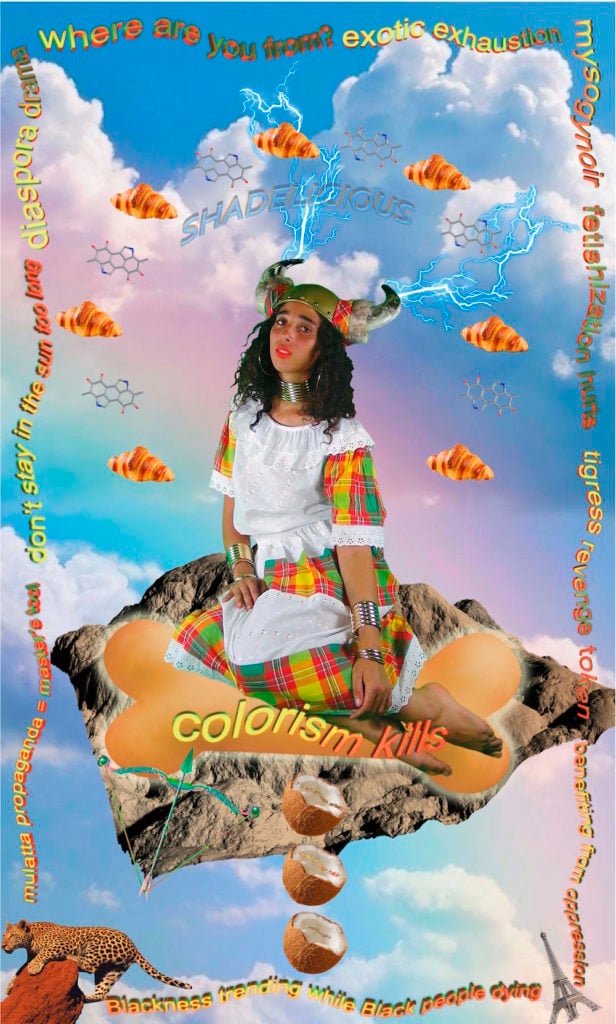
Tabita Rezaire, Inner Fire: Shadelicious (2016). Courtesy the artist and Goodman Gallery, Johannesburg and Cape Town.
Born: 1989
Based in: Cayenne, French Guiana
Appeared in: Performa 2017; Athens Biennale 2018; Guangzhou Triennial 2018; Kochi-Muziris Biennale 2018; Moscow International Biennale for Young Art 2018; Göteborg Biennial 2021; Shanghai Biennale 2021; Biennale Gherdëina 2022; Sydney Biennale 2022
Notable Works: Sugar Walls Teardom (2016); Mamelles Ancestrales (2019); Deep Down Tidal (2017)
New media artist Rezaire’s practice is focused on the concept of healing. She often appears as a “digital shaman” in her trippy, psychedelic videos and prints. Inspired by quantum and cosmic mechanics, she “uses art as a means to unfold the soul,” according to her website. Her digital healing and energy streams are intended to remind viewers to access “our own inner data center, to bypass western authority and download directly from source.”
Mamelles Ancestrales, presented at the Sydney Biennale, is inspired by African interpretations of the cosmos as well as the ancient stone circle monuments referenced in her work, calling into question whether scientific explanations should supersede spiritual ones. Meanwhile, Deep Down Tidal—seen at the water-themed 23rd Biennale of Sydney—“navigates the ocean as a graveyard for Black knowledge and technologies,” the artist says. “Research suggests that water has the ability to memorize and copy information, disseminating it through its streams. What data is our world’s water holding?”
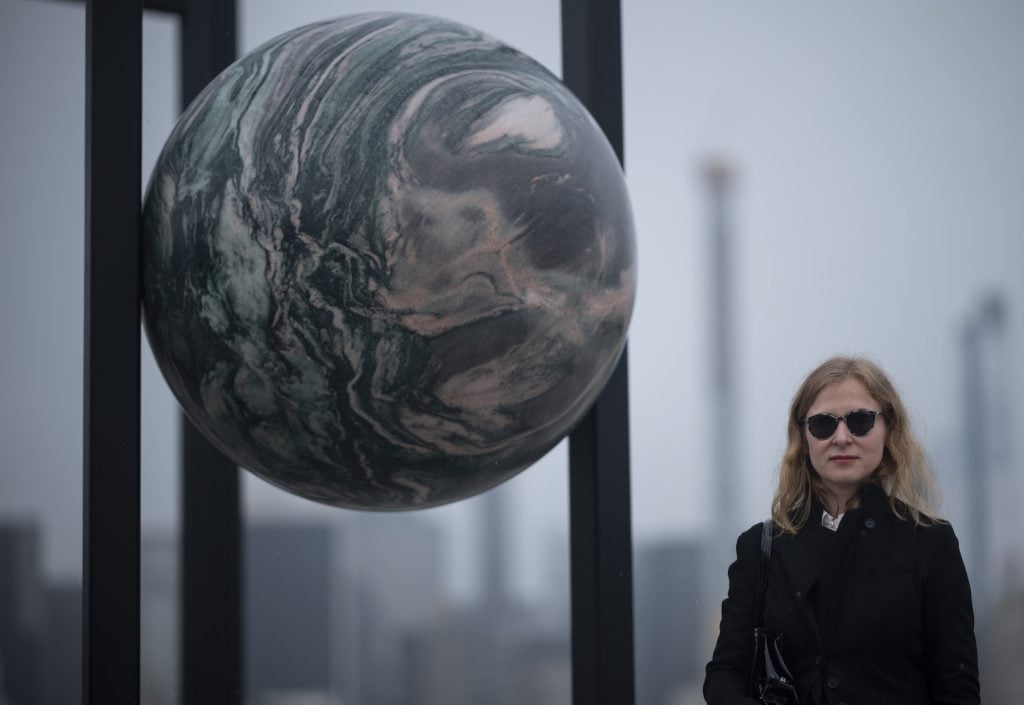
Berlin-based artist Alicja Kwade poses in her sculpture ParaPivot atop the Metropolitan Museum of Art on April 15, 2019 in New York City. (Photo byJohannes Eisele/AFP via Getty Images)
Born: 1979
Based in: Berlin
Appeared in: ARoS Triennial 2017; Biennale Gherdëina 2018; Thailand Biennale 2018; Desert X AlUla 2020; Helsinki Biennial 2020; Desert X 2021; Riga Biennial 2022; Setouchi Triennale 2022
Notable Works: Pars pro Toto (2018); ParaPivot I and II (2019); Big Be-Hide (2019)
In theory, this Poland-born artist is about as heady as it gets, dealing about the nature of time, reality, and space, and riffing on science and philosophy. “Reality is just a term—a construction,” she told Bomb on the occasion of her rooftop commission, Pars pro Toto, for the Metropolitan Museum in New York. “There are only descriptions that relate to our reality. Nobody knows what reality means, and there are different ways to understand it.”
In person, however, her work is a startling sensual form of conceptual minimalism. Kwade has benefited from a rage for shows engaging with nature. Works from her “Be-Hide” series, showing stones artfully positioned in nature facing mirrors, were shown at the garden-themed ARoS Triennial in Aarhus, Denmark, at the first Thailand Biennale, “Edge of Wonderland,” which was staged outdoors, and at Helsinki Biennial’s ecology-themed premier edition.
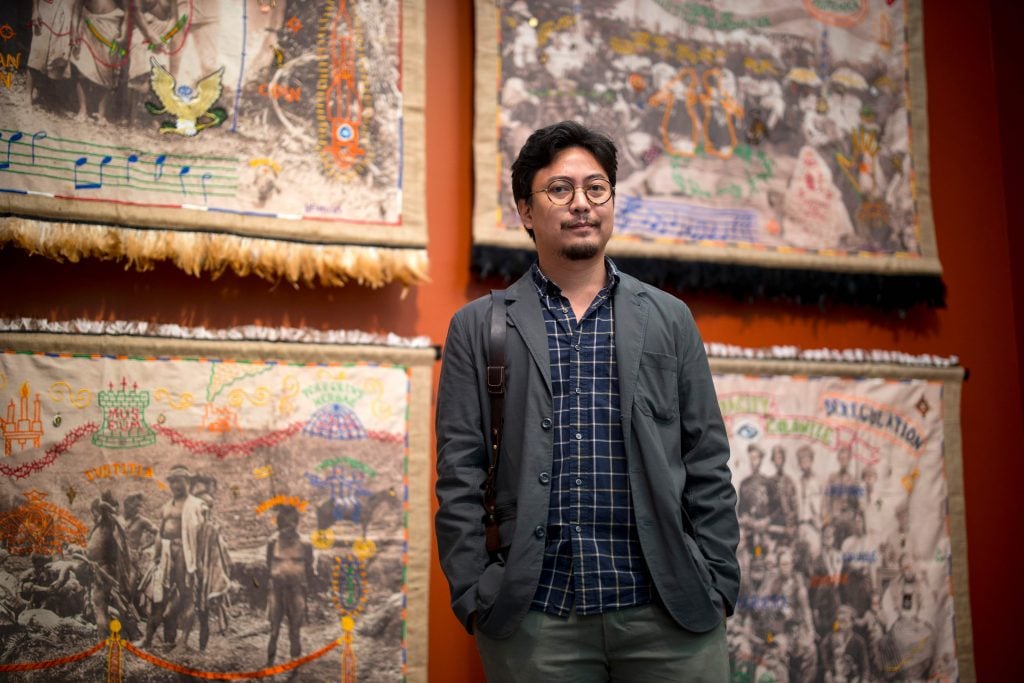
Filipino artist Cian Dayrit at Frieze in London. (Photo by Tolga Akmen/AFP via Getty Images)
Born: 1989
Based in: Manila, the Philippines
Appeared in: Berlin Biennale 2020; Göteborg Biennial 2019; New Museum Triennial 2018; Momentum Biennial 2021; Gwangju Biennale 2021; Sydney Biennale 2022; Dhaka Art Summit 2018; Kathmandu Triennale 2022
Notable Works: Anatomy of Aggression I and II (2020); Tropical Terror Tapestry (2020); Occultas Archipelagus (2017); Civilized Society (2017)
“Counter-cartography” is a phrase Filipino artist Cian Dayrit has used to describe his best known works, an ongoing series of hand-embroidered textiles that transform historic maps into portraits of contemporary social conditions. But the term also broadly outlines his practice, which seeks to chart the ways in which imperialism, industrialization, and other systems of subjugation have shaped geographical boundaries and cultural narratives across the Global South—especially in his home country of the Philippines. “I wanted to challenge the perspectives that somehow monopolized the framing of history and heritage,” he told A Magazine Singapore in 2021. Often, Dayrit’s artistic efforts begin with community workshops around his hometown of Manila.
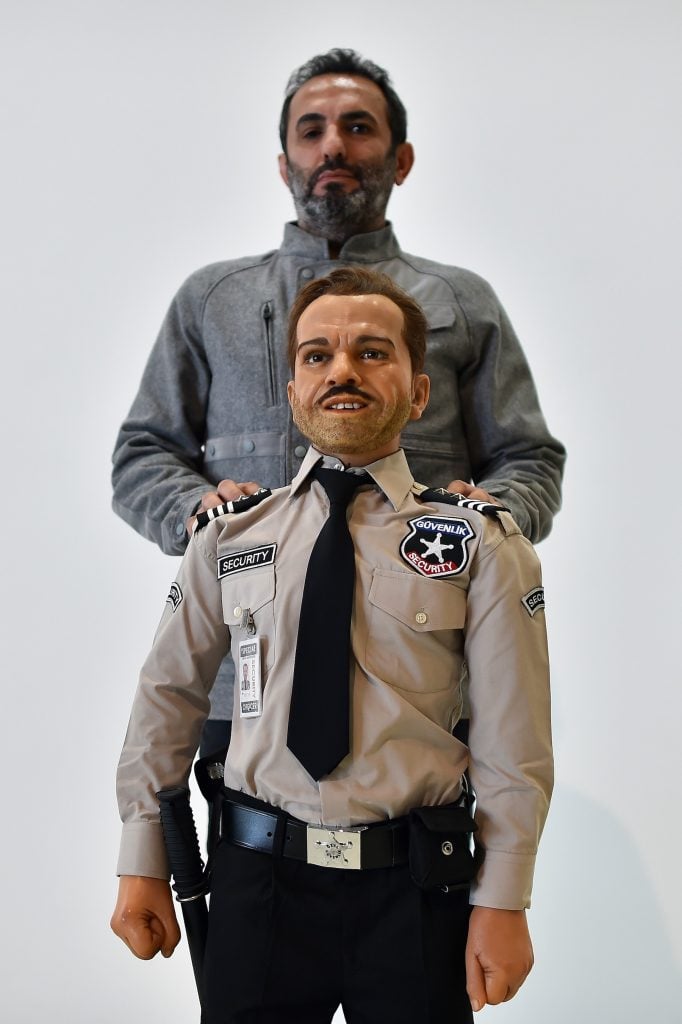
Turkish artist Halil Altindere poses with his sculpture Guard, part of the exhibition “Istanbul, Passion, Joy, Fury” at the Maxxi museum in Rome during the media preview on December 10, 2015. (Photo credit should read Gabriel Bouys/AFP via Getty Images)
Born: 1971
Based in: Istanbul
Appeared in: Thessaloniki Biennale 2017; Gwangju Biennale 2018; Lahore Biennial 2018; Art Encounters Biennial (Romania) 2019; Bienalsur 2019; Venice Biennale 2019; Lahore Biennial 2020; Riga Biennial 2022
Notable Works: Wonderland (2013); Space Refugee (2016)
Altindere makes works that find engaging, creative ways to put the spotlight on very serious issues, in Turkey and beyond. In the era of the Taksim Square protests in Turkey, he became well known for Wonderland, a video that uses the form of a hip-hop music video to give visibility to the dispossession and alienation of Romani youth in Istanbul. Even more ambitious was his multi-part, multi-media piece Space Refugee, working with Muhammad Faris, the first Syrian astronaut who has since become a refugee from the Asad regime, both telling his story and imagining what a Martian space city for displaced Syrians might look like.

Ian Cheng speaks at Appraisers Association of America on April 18, 2018 in New York City. (Photo by Sean Zanni/Patrick McMullan via Getty Images)
Born: 1984
Based in: Los Angeles
Appeared in: Bienalsur 2017; Yokohama Triennale 2017; Biennale de l’Image en Mouvement 2018; Ghost Festival 2018; October Salon/Belgrade Biennale 2018; Sharjah Biennial 2019; Venice Biennale 2019; October Salon/Belgrade Biennale 2021
Notable Works: BOB (Bag of Beliefs) (2018–19)
Ian Cheng is known for his “simulations,” video games that play themselves, with results surprising for both the viewer and the artist. These A.I. ecosystems star humans, plants, and creatures such as BOB (Bag of Beliefs) (2018–19), an interactive work of art centering on an evolving artificial intelligence creature with a physical appearance that evokes a serpent or coral, shown, among other places, at the 2019 Venice Biennale.
Life After Bob was Cheng’s first animated film, commissioned by the Shed, Luma Foundation, and Light Art Space, expanding on the BOB lore. It takes place “in a weird, volatile, and changing world, a very transitional world,” Cheng said in an interview, “similar to the world that we live in.”
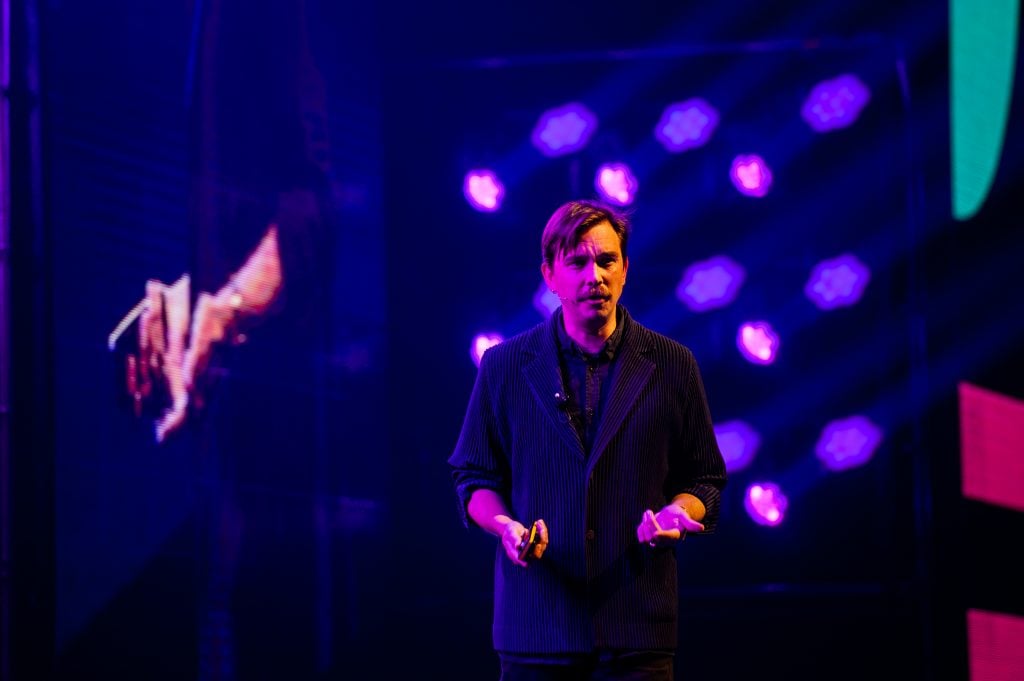
James Bridle at the TNW (The Next Web) conference. (Photo by Ana Fernandez/SOPA Images/LightRocket via Getty Images)
Born: 1980
Based in: Greece and London
Appeared in: 2017 Thessaloniki Biennale; 2018 Manifesta Biennial; 2019 Coventry Biennial; 2019 Aichi Triennale; 2019 Vienna Biennale; 2021 Belgrade Biennale; 2021 Guangzhou Image Triennial; 2022 British Art Show
Notable Works: New Aesthetic (2011); Dronestagram (2012–15)
What will architecture look like in the future? How can we uncover and visualize the mechanisms of surveillance and control that exert power over us without our knowledge or consent? These and other questions are the subjects of the work of James Bridle.
The artist and writer’s projects have involved sending a self-driving car up Mount Parnassus, the classical home of the muses; creating a live video installation that ingests news coverage and directs visitors toward the point in Europe with the best (or least dangerous) opinions on refugees; and plotting aerial photographs of unreported drone-strike locations on the Instagram account Dronestagram. Through video, books, performance, installation, and more, Bridle aims to synthesize and visualize the hidden, diffuse forces that guide our world both on and offline.
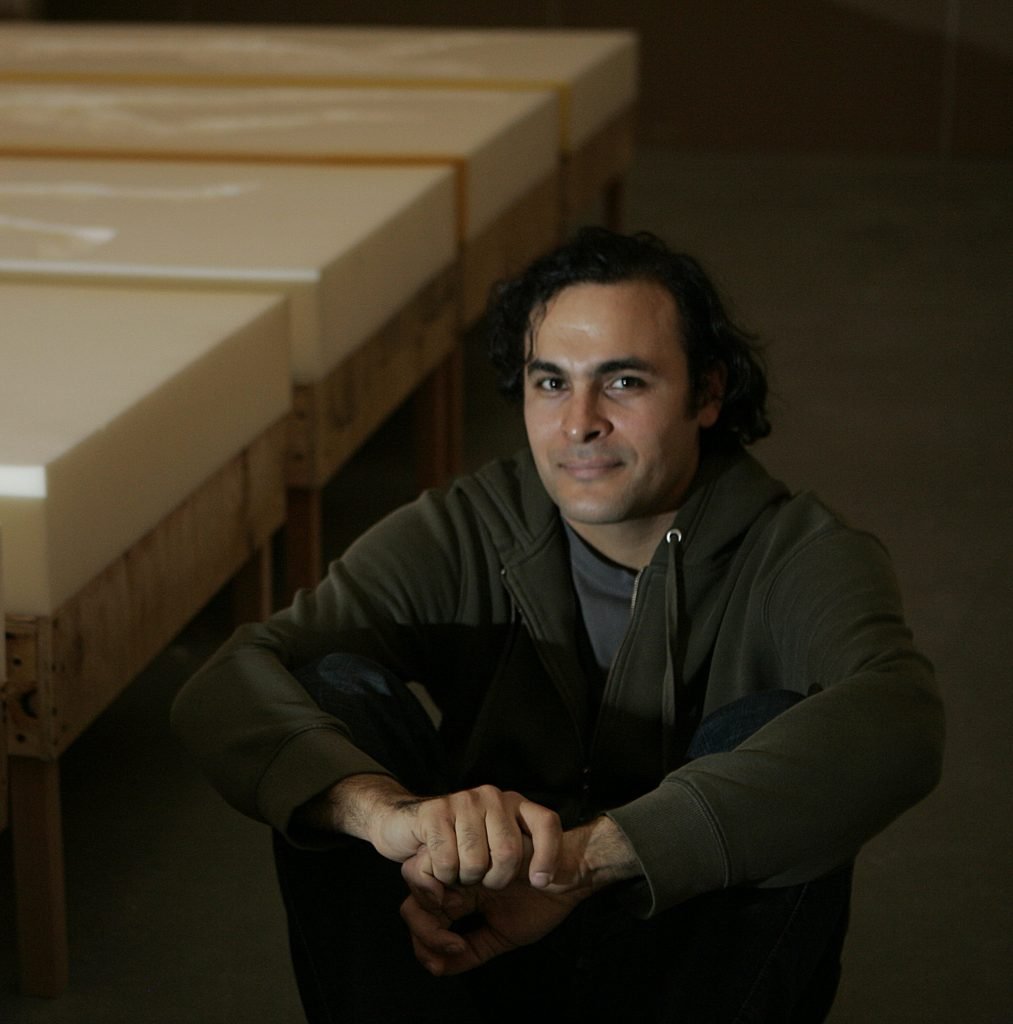
Artist Kader Attia along with his art at the Institute Of Contemporary Art. (Photo by David L Ryan/The Boston Globe via Getty Images)
Born: 1970
Based in: Berlin
Appeared in: Gwangju Biennale 2018; Manifesta 2018; Prospect New Orleans 2018; Shanghai Biennale 2018; Lahore Biennial 2020; Bienalsur 2021; Aichi Triennale 2022; Sharjah Biennial 2023
Notable Works: Réfléchir la Mémoire (Reflecting Memory) (2016); The Body’s Legacies. The Post-Colonial Body (2018)
“Repair” is a key word for Attia, who thinks of himself as repairing and adapting culture rather than creating new culture from nothing. His works are poetic yet bracing, often putting colonialism and political trauma front and center in his installations and objects. For The Body’s Legacies. The Post-Colonial Body (2018), he interviewed four people whose ancestors were either enslaved or colonized, switching between registers of the intimate and the analytical.
“I’m very interested in ideas of keeping the thread of the genealogy and history of why we are here,” he said in an interview with the Harbourfront Center in 2018. Attia is also the curator of the 2022 Berlin Biennale—another way to bring many of the same themes to the international art circuit.
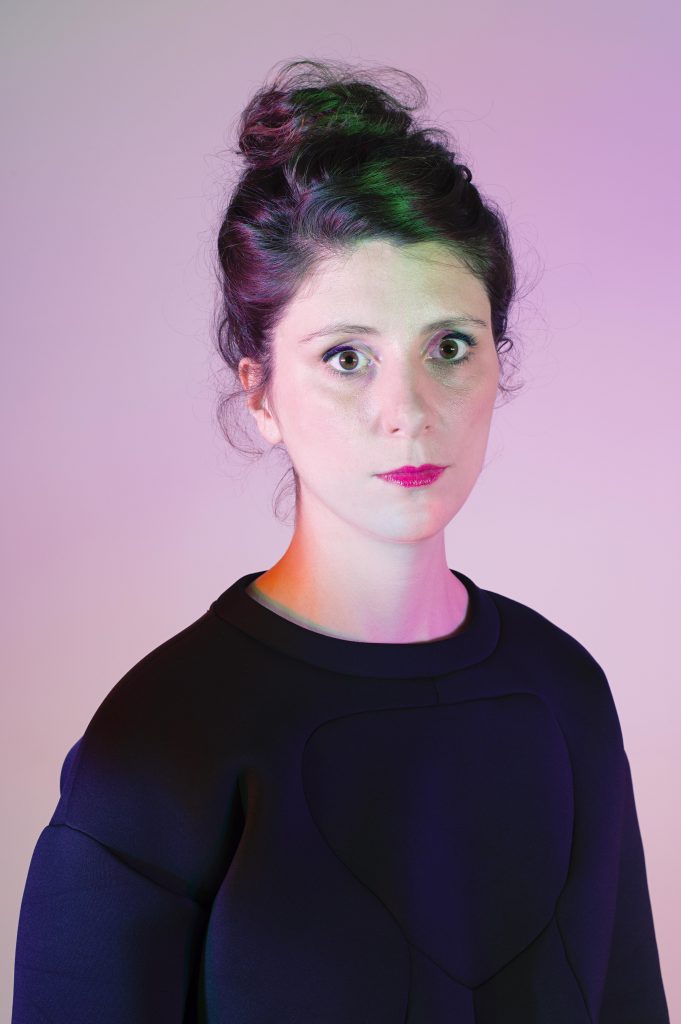
Marguerite Humeau. Photo: Noortje Knulst and Julia Andreone.
Born: 1986
Based in: London
Appeared in: October Salon/Belgrade Biennale 2018; Istanbul Biennial 2019; Riga Biennial 2020; October Salon/Belgrade Biennale 2021; Sydney Biennale 2022; British Art Show 2022; Venice Biennale 2022
Notable Works: The Myth Teller (2019); High Tide (2019); Migrations (2022)
Since she burst onto the scene in 2011 with The Opera of Prehistoric Creatures, a work that grew out of her thesis show at the Royal College of Art in London that saw her recreate the cry of the wooly mammoth, Humeau has been on quite a run.
Often her work takes the form of collaborating with scientists to solve some speculative puzzle about the past. From the process, she produces various eerie artworks, often appearing as eerie sculptures that look like aliens escaped from the lab. The works in her “High Tide” series, shown at the British Art Show in 2021, are inspired by the idea of animals achieving spiritual consciousness, emerging from her speculations about what non-human rituals creatures like elephants or chimpanzees might evolve to cope with their mortality, in an age of extinction.
“All the worlds I am creating are based on real facts; they are based on mysteries that I am trying to understand,” Humeau told Studio International. “I am extracting real things, and then expanding into ‘what if?’ scenarios.”
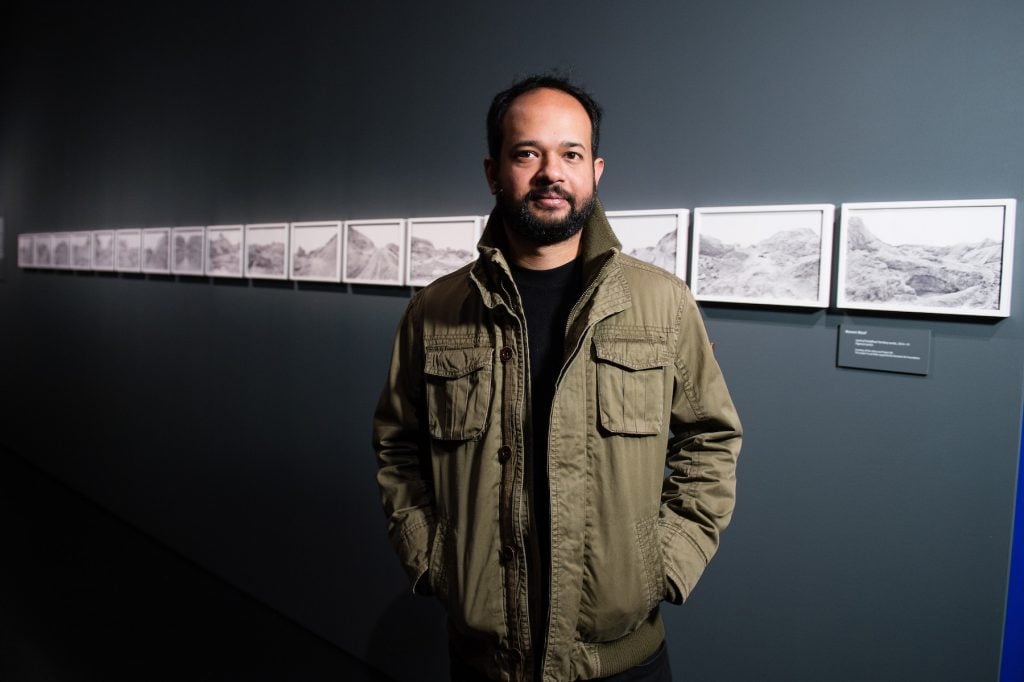
Photographer Munem Wasif pictured with his work on May 4, 2017 in London, England. (Photo by Jeff Spicer/Getty Images for Prix Pictet)
Born: 1978
Based in: Dhaka
Appeared in: Asia Pacific Triennial 2018; Dhaka Art Summit 2018; Gwangju Biennale 2018; Sharjah Biennial 2019; Industrial Art Biennial (Croatia) 2020; Lahore Biennial 2020; Taipei Biennial 2020; Lyon Biennale 2022
Notable Works: Machine Matter (2017); Seeds Shall Set Us Free II (2019)
As a photographer, Wasif is known for the elegance and poetry of black-and-white images, documenting life in Bangladesh in various ways. But he’s also moved beyond that medium, though with the same evocative sensibility: “At the end photography becomes irrelevant and it’s more about what you want to say,” Wasif has said. “The inspiration comes from literature, music, film, and life in general.”
For Machine Matter (2017), seen at the Sharjah Biennale, Wasif offered a meditative video installation reflection on the legacy of jute textiles in Bangladesh. At the Taipei Biennial, he presented Seeds Shall Set Us Free II, mixing archives and photography to create an installation in collaboration with UBINIG, a Dhaka-based organization that works against corporate agriculture, to give a sense of the collective struggles of farmers.